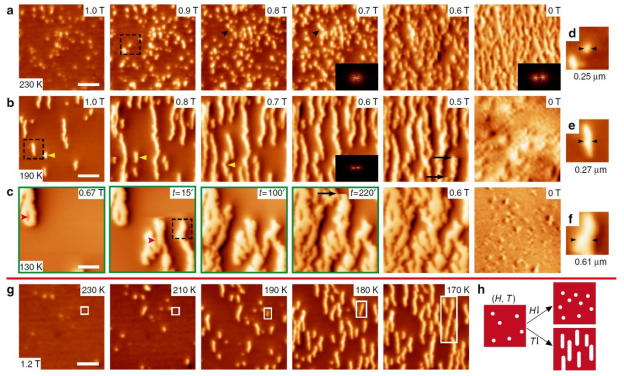Owing to various coupled interactions in the colossal magneto-resistive manganese oxide, competing thermodynamic phases can coexist. Studying evolution behavior of these interactions in real space helps to understand role they play in the phase separation. Therefore, real space observation of the phase separation is a hot one in this research field.
However, transitions among the phases are triggered only in fairly strong magnetic field which is rarely seen at present. In this case, the process of entire phase separation loop from charge order state to its re-appearance has not been observed in manganite film.
Over more than one year of collaboration between a study team led by LU Qingyou of High Magnetic Field Laboratory, Chinese Academy of Sciences and a study team led by WU Wenbin of University of Science and Technology of China, the complete process has been observed in a type of anisotropic strain regulated phase separation manganite film through a homebuilt 20 T strong field magnetic force microscope. This progress was published in the journal of Nature Communications (6:8980) with the title “Evolution and Control of the Phase Competition Morphology in a Manganite Film”.
As we know, A bulk La0.67Ca0.33MnO3 is an optimally doped ferromagnetic metal. However, researchers found that special phase competition can be induced in the post-anneal treated La0.67Ca0.33MnO3 film on NdGaO3 (001) due to the anisotropic strain from the substrate. Below the ferromagnetic phase transition temperature TC, new ferromagnetic-antiferromagnetic transition (TAFI) and antiferromagnetic-ferromagnetic transition at even lower temperature (TC’) occur. From the transport measurement, the resistivity curve, as a function of temperature, shows large hysterisis below TAFI, which suggests the existence of phase separation state below TAFI.
In the phase diagram, this type of phase separation can be further divided into charge order insulator dominant phase separation (COI-PS) and ferromagnetic metal dominant phase separation (FMM-PS), which have different curves of resistivity vs. magnetic field (p-H) (Fig.1b). In the process of increasing field, due to the COI gradually transforms into the FMM, resistivity drops at both temperature 10K and temperature 150K. When the field is reduced after the FMM saturates, the COI re-appears at 150K, which is not seen at 10K.
Actually, in other manganites with COI as the ground state, such as Pr1-xCaxMnO3, Nd1/2Sr1/2 MnO3 and LaPrCaMnO3, this type of COI re-appearance in the process of decreasing field was also observed, which, however, was realized either in zero field or in the process of increasing field. Therefore, the details of COI re-appearance in decreasing field remain unknown, which is undoutedly important for providing insight into the mutual transitions between FMM and COI.
Using a homebuilt high field magnetic force microscope (Ultramicroscopy 147, 133(2014)), researchers systematically imaged the sample’s phase separation behaviors, particularly the re-appearance of COI in decreasing magnetic field. It shows microscopically that the re-appearing process of COI is totally different from the COI melting process in increasing magnetic field and has diverse morphologies (Fig.2).
The COI domains present in droplets, stripes and puddles at 230K, 190K and 130K, respectively. The domain size of COI increases when the temperature decreases and correspondingly the melting field of the COI phase increases as the temperature reduces, which shows strengthening of the COI phase. Based on this, researchers propose a physical picture: COI is weak at a high temperature (230K) and the re-appearing COI domains are in small droplets. It becomes stronger at a lower temperature of 190K and the corresponding domain size of COI gets larger, where the anisotropic strain drives the COI domains to grow along a certain lattice orientation. Thus, the COI morphology (stripes) reflects the epitaxial strain characteristic. At 130K, an even lower temperature, the COI becomes so strong that its main cause (Jahn-Teller distortion) overwhelms the anisotropic strain and its morphology (irregular puddles) reflects the characteristic of the Jahn-Teller distortion. Hence, this study is of importance to provide light on how the competing aspects interact with each other based on the morphology of the competing phases. Meanwhile the control of the phase competition morphology could be realized.
The first author of the paper is ZHOU Haibiao, a Ph.D. Student. LU Qingyou and WU Wenbin are the corresponding authors. This study is supported by the National Natural Science Foundation of China and the National Basic Research Program of China.

Fig.1. Transport measurements of La0.67Ca0.33MnO3/NdGaO3 (001)film (Image by the study team)

Fig.2. The evolution and control of the morphology of the re-appeared COI in La0.67Ca0.33MnO3/NdGaO3 (001)film at different temperatures as a result of decreasing the magnetic field. (Image by the study team)
Contact:
LIU Qingyou, Professor
High Magnetic Field Laboratory, Chinese Academy of Sciences
350 Shushanhu Road
Hefei, Anhui, 230031, P. R. China
+86-551-65595198